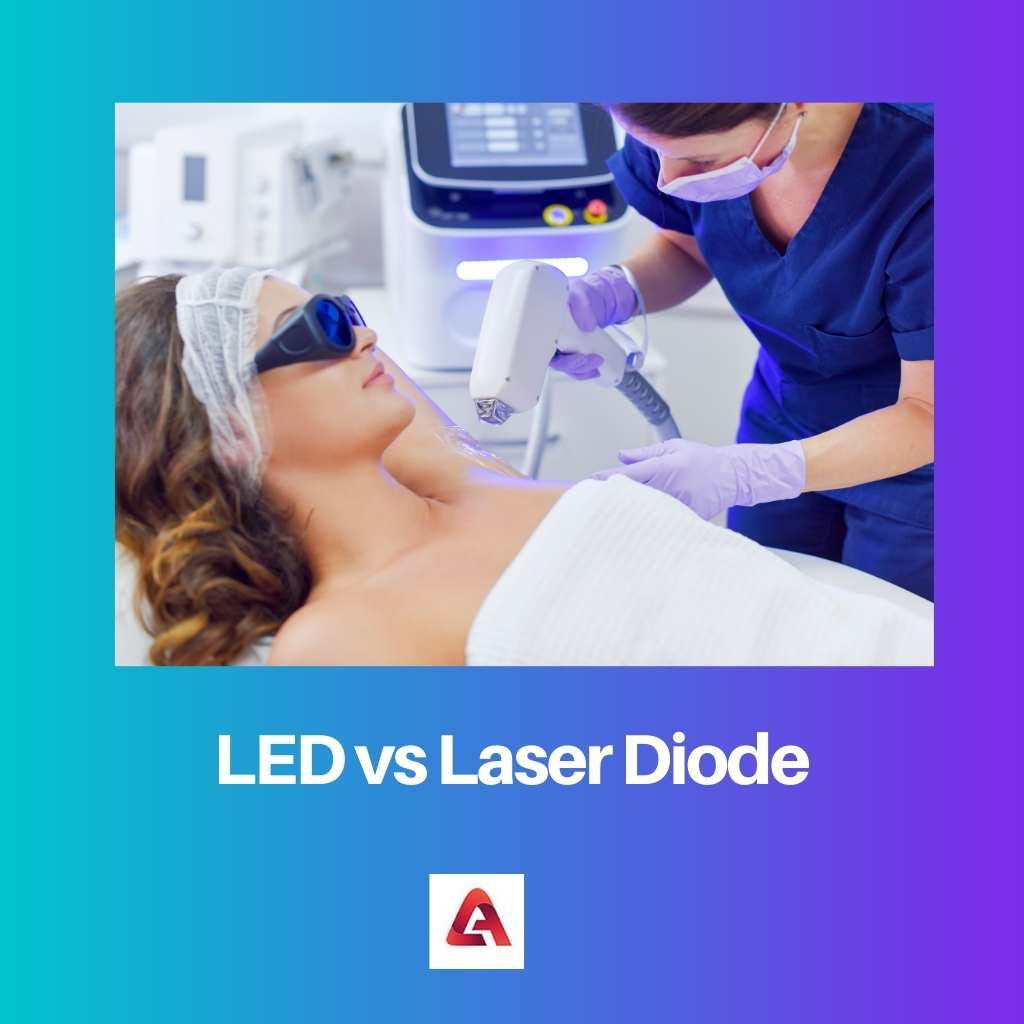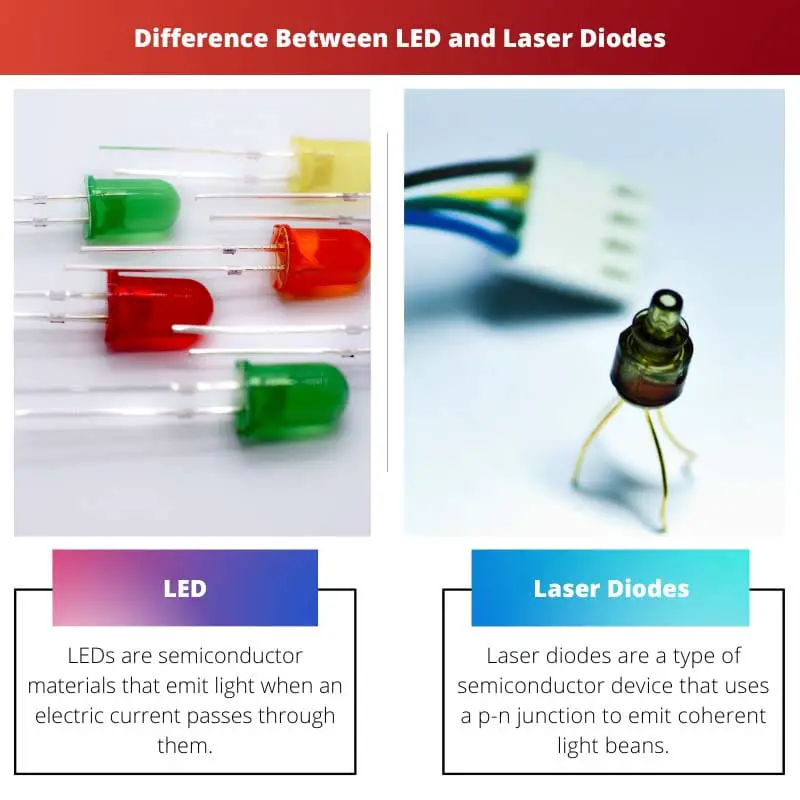There are several types of semiconductor devices used for emitting light. LEDs and laser diodes are very commonly used flashlights, medical devices, traffic signals, etc., but the main difference between these two devices lies in the working principle.
The nature of the light emitted by these devices is also different and hence has different applications.
Key Takeaways
- LED (Light Emitting Diode) diodes emit light by passing an electric current through a semiconductor material, while laser diodes produce coherent light through the stimulated emission of photons.
- Laser diodes emit a more focused, intense, and directional light than LEDs, producing diffused and wider light.
- LED and laser diodes are used in various applications, such as lighting, communication, and electronics, but their distinct properties make them suitable for different purposes.
LED vs Laser Diode
LEDs work by converting electrical energy directly into light energy through a process called electroluminescence. LEDs are commonly used in a wide range of applications. Laser diodes, on the other hand, emit light through stimulated emission. Like LEDs, laser diodes are made of semiconductor materials.

LED emits light energy when the majority and minority charges (electrons and holes) recombine in the forward bias p-n junction.
The electrons and holes are at different energy levels, so when the former jumps from the conduction band to the valance band, some energy is released and is used for emitting light.
Laser diodes are extensively used in telecommunication,; this device’s main parts are a photodiode, laser, glass lens at the front, and fibre.
Laser diodes work on the principle of stimulated emission, and the concentration of charge carriers is very high in laser diodes.
Comparison Table
| Parameters of Comparison | LED | Laser Diode |
|---|---|---|
| Definition | LEDs are semiconductor materials that emit light when an electric current passes through them. | The complete form of LED is Light Emitting Diode. |
| Full-Form | The complete form of laser is light amplification by stimulated emission of radiation. | The response time of laser diode is much faster than LEDs. |
| Working Principle | The main working principle of a LED is based on electro-luminance. | The main working principle of a laser diode is stimulated emission. |
| Response Time | Response times of LEDs are much slower than laser diodes. | The current driving ranges from 50mA to 100mA. |
| Current | The current driving ranges from 5mA to 40mA. | The response time of laser diodes is much faster than LEDs. |
| Nature | The light emitted by LED is incoherent and comprises various colours. | The light emitted by the laser diode is coherent and monochromatic. |
What is LED?
An LED device is best described as a p-n junction diode from where light emits when current passes through it.
In the junction area, the electrons from the n side combine with the holes from the p side and emit enough energy in light (and heat).
The light energy that is formed is radiated through the junction of the diode. Single LEDs are used for making decimal points, whereas several LEDs are used together to create a line segment.
To understand the working of an LED, one needs to understand quantum theory because it is related to the movement of electrons from higher to lower energy levels.
During the construction of an LED, it is connected in the forward bias so that the current flows in the forward direction. The electrons move in the opposite direction.
Since there is an energy gap between the conduction band and the valence band, the difference in this energy is equal to the power of the photons.
There are several advantages of using LED in electronic displays. For example, the intensity of the LED lights can be controlled very smoothly; unlike laser diodes, they emit various colours such as green, red, yellow, etc.
They are also very economical for both domestic and industrial purposes.

What is Laser Diode?
Laser diodes are extensively used, especially for scientific and medical purposes. The light emitted from a laser diode forms a narrow beam and can be quickly launched from an optical fibre.
Monochromaticity is one of the main characteristics of the light emitted by laser diodes. Because they contain only a single colour, they have large medical applications.
The light beams emitted by the laser diodes are also coherent,, meaning that only a single wavelength is present. There are two classes of laser diodes, one that can emit light by itself and another that uses an external source.
Laser has a big advantage: light can travel very distances. Besides the fact that it can travel long distances, there are other advantages of using laser diodes.
For example, laser diodes consume low power, they can operate for long hours, the manufacturing cost of this equipment is also common, and their small size makes them easily portable.
Among several advantages, laser diodes also have a few disadvantages.
The most significant disadvantage is that the light emitted by the laser is harmful to our eyes, and the performance of the device varies because of the rise in temperature (vulnerable to high temperature).

Main Differences Between LED and Laser Diode
- The working principle of LED and laser diode is different. While the former works on electro-luminance, the latter works on stimulated emission.
- The driving current for LED is more than that of laser diodes.
- LED lies in a broad bandwidth range (10THz to 50THz), whereas laser diodes lie in a narrow bandwidth range (1MHz to 2MHz).
- In LED, the concentration of the charge carriers is much lower than that of the laser diodes.
- LED has a wider junction area, and hence light passes through a very wide space, whereas laser diodes have a very narrow junction area.

- https://ieeexplore.ieee.org/abstract/document/999188/
- https://www.nature.com/articles/nphoton.2014.326?draft\u003djournal
